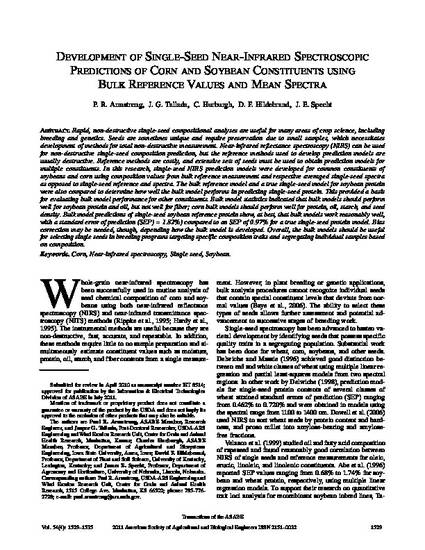
Rapid, non-destructive single-seed compositional analyses are useful for many areas of crop science, including breeding and genetics. Seeds are sometimes unique and require preservation due to small samples, which necessitates development of methods for total non-destructive measurement. Near-infrared reflectance spectroscopy (NIRS) can be used for non-destructive single-seed composition prediction, but the reference methods used to develop prediction models are usually destructive. Reference methods are costly, and extensive sets of seeds must be used to obtain prediction models for multiple constituents. In this research, single-seed NIRS prediction models were developed for common constituents of soybeans and corn using composition values from bulk reference measurement and respective averaged single-seed spectra as opposed to single-seed reference and spectra. The bulk reference model and a true single-seed model for soybean protein were also compared to determine how well the bulk model performs in predicting single-seed protein. This provided a basis for evaluating bulk model performance for other constituents. Bulk model statistics indicated that bulk models should perform well for soybean protein and oil, but not well for fiber; corn bulk models should perform well for protein, oil, starch, and seed density. Bulk model predictions of single-seed soybean reference protein show, at best, that bulk models work reasonably well, with a standard error of prediction (SEP) = 1.82%) compared to an SEP of 0.97% for a true single-seed protein model. Bias correction may be needed, though, depending how the bulk model is developed. Overall, the bulk models should be useful for selecting single seeds in breeding programs targeting specific composition traits and segregating individual samples based on composition.
Available at: http://works.bepress.com/charles_hurburgh/23/

This article is from Transactions of the ASABE 54 (2011): 1529–1535. Posted with permission.